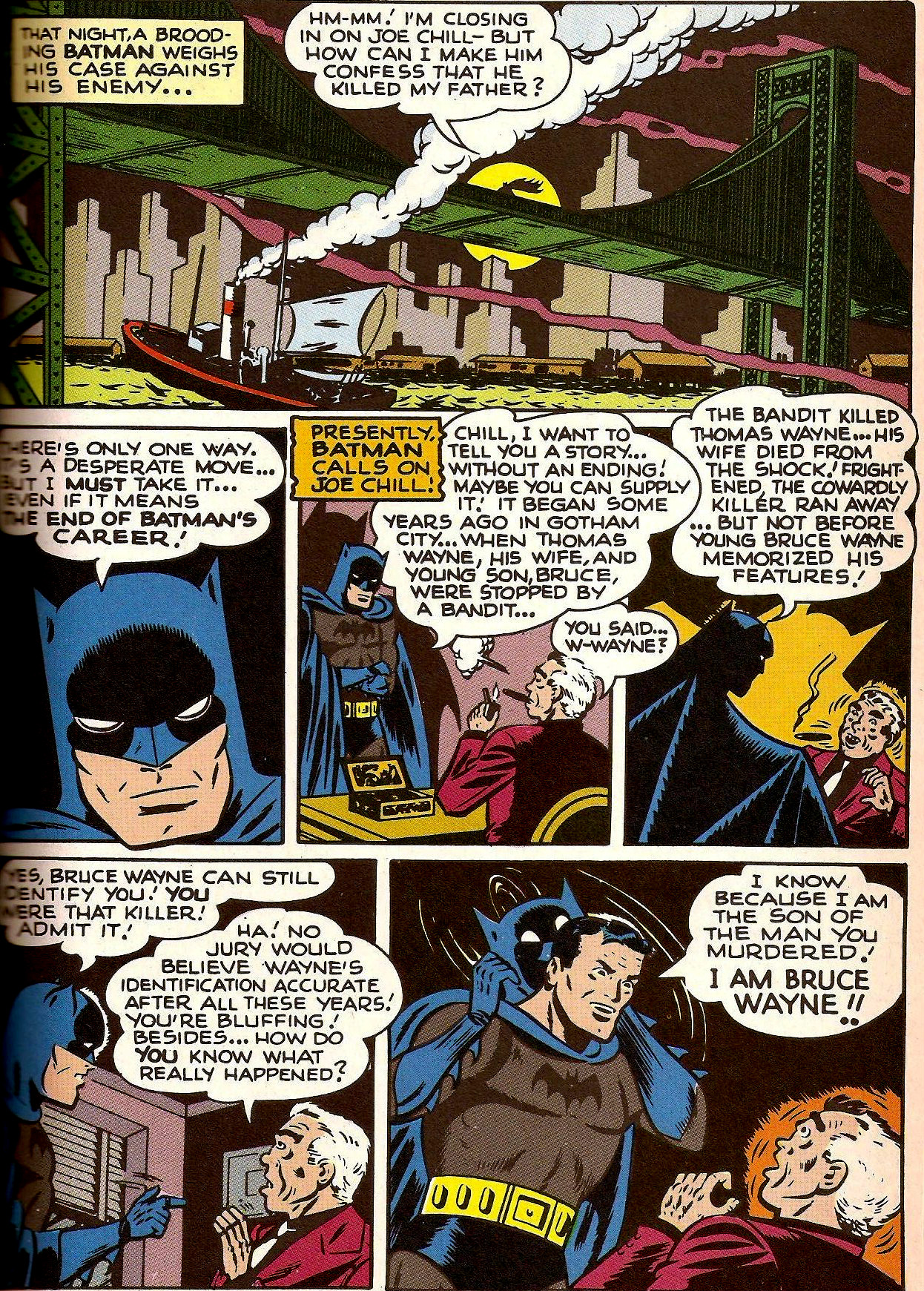
From Batman (Vol. 1) #47 (1948)
For years, all that was known about the killer of Thomas and Martha Wayne was that he was a simple random mugger. In 1948, that changed with a Batman story written by Bill Finger and pencilled by Bob Kane. In the pages of Batman #47, the Dark Knight stumbled across Joe Chill, a seemingly minor racketeer operating in Gotham City. When Batman came face-to-face with Chill, he realized that this man was the gunman who shot his parents so many years ago. Unable to think of any other way to force a confession out of Chill, Batman did the only thing he could do: He revealed his secret identity to Chill in the hopes that it was jar the truth out of him.
This page, with its slow build and startling conclusion, shows Finger and Kane working together extremely well. Finger’s story of Bruce Wayne finally coming face-to-face with the man who changed the course of his life is a strong one and Kane’s drawing of Batman leaning over a frightened Chill in the fourth panel still works. The final panel reveal is still shocking to readers these many decades later as it means the Joe Chill is only the third person in the world to know that Bruce Wayne is really Batman. There’s a lot of story happening in this one page, but it all works.


1. “His wife died from the shock”?
2. This seems like as good a time as any to bring “bandit” back into popular use.
Yeah, the whole “Martha Wayne dying from shock” thing was a weird retcon. In the original telling of this tale, it’s clearly shown that the mugger shot both Thomas Wayne and Martha separately. Check out the original page from Detective Comics #33 from 1939.
In other news, the colorist for Detective 33 used magic markers.
Well, Martha dying from shock is the more archetypal way to go about a tragic origin. I’m not sure where or when the change came about, but I think it might have been better to stick with it. What we know as his origin gains in brutality, but loses in mythic quality.
So many classic elements on one page.
Just beautiful.
I had no idea that scene from Morrison’s run was based on this confrontation. It’s not surprising, since half the run was based on Golden and Silver Age wackiness, but it’s still news to me. Interesting.
Refresh my memory, in Morrison’s Bruce doesn’t remove his mask but he gives Chill the clues he needs to figure it out. And then Chill has a heart attack? offs himself?
Panel 2 might be my favorite thing about this page.
Classic Batman brooding so much his chin pushes out of the panel.
Good point.
The “eyes-and-forehead always in shadow even though nose and jaw are thrust into the light” thing is so rote it’s in every single panel at this point. So much so they designed the 60s TV mask and cowl to have those as decorative elements, to give Batman the “classic comic-book look”.
I’m going with Panel One. From the “Batman silhouetted against the full moon (which constantly moves in the sky so as to be continually behind him when artistically convenient)” element to the “classic shot across the East River, looking at Manhattan” sense of locale, to the intertwining mist and smoke which intertwine with the very bridge Batman seems to be racing across, (perhaps on a motorcycle), to the use of color for these elements, which seem to portray Joe Chill as a puffed-up little tugboat, later in the page, and serve as a reminder of his Mack-the-Knife sort of bloody relationship with the docks and the River, to the restrained yet poetic use of a limited palette within the panel and the page as a whole, I find in it a template and an inspiration for an entire mythos.
Batman: Brave and the Bold did a great episode based on this.
That confrontation is so intense. I wonder if that original page still exists.
Bill Finger got the sort end of the stick, he was essential to the creation of Batman, but Bob Kane got all the glory. I seem to remember Jerry Robinson saying that Bill had more to do with creating Batman than Bob. This is an example of how crucial his stories were to the Batman mythology.
I’m reminded of that Johns/Lee JL where Batman revealed to GL his secret identity, except noboby is screaming that Batman would NEVER remove his cowl in the presence of another.
Batman had clear motivation here. To be fair, Batman had motivation in the Justice League, but it was written by a 7 people so nobody can tell it was there.
I find it amusing that Batman has done this on at least several occasions in his history, but when he did it in that JL issue, the Internet nearly exploded with people proclaiming that would and could NEVER happen. The above is just another example to contradict that misconception. AND, he revealed himself to a villain no less. 😉